Palestine 6 December 2005
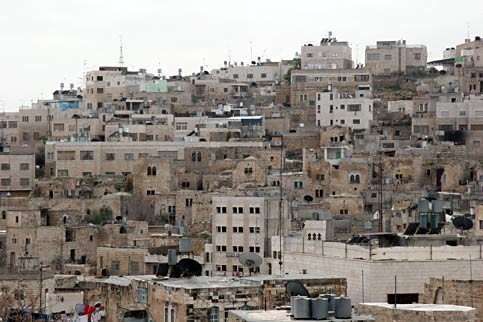
The city of Hebron, under curfew. (Photo: Bob Haynes)
March 8, 2005 in Hebron (Al Khalil in Arabic) — The main road to Hebron that Palestinians have taken for years is blocked, so we have to take an alternate route. We cross the Israeli military checkpoint that blocks the southern entrance to Bethlehem. We pass a Palestinian refugee camp, and clusters of Israeli settlements collectively known as the Gush Etzion block, south of Bethlehem. We see how new Israeli settlements start out as illegal outposts of a few rows of mobile homes, and over time turn into Southwest-style villa townhouses that would fit right in, if we were in Southern California. Then there are Israeli military bases taking up even more West Bank land to guard the settlements.
We arrive at one of the first, and one of the most ideologically right wing settlements in the West Bank, Kiryat Arba. We pass the checkpoint, and are allowed inside, past the electric fence, into the heart of this settlement of 6,500 people.
It is the largest in the central Hebron area, but there are now 5 other Jewish enclaves within the Old City with an additional 400-500 Jewish Settlers: Tel Rumeida, Beit Hadassa, Beit Romano, Abraham Avion, and the Gutnic Center. They are supported by between 1,500 to 2,000 Israeli soldiers.
In central Hebron, conflicts with the native Palestinian population of 130,000 include land confiscation and historic house demolitions, which are taking place to create a corridor linking up the 5 Jewish enclaves and the larger settlement of Kiryat Arba. This will create a settler complex that includes the Ibrahim Mosque (Tomb of Abraham), one of the holiest sites to Muslims and Jews, as well as Christians.
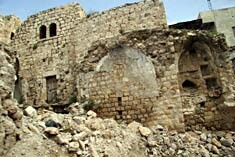
Ancient Palestinian dwellings in central Hebron destroyed for nearby settlement “security reasons”. (Photo: Bob Haynes)
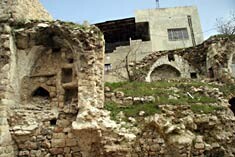
More destroyed antiquities in the central Hebron area. (Photo: Bob Haynes)
In Kiryat Arba, we disembark our bus and head inside a community center. There we meet Mr. Elyakim Ha’itzni, an attorney, and one of the original founders of the settler movement in the West Bank and Gaza. There are now more than 270,000 settlers in the West Bank and Gaza, more than 400,000 if you include East Jerusalem. “I hope we are a thorn in their sides,” remarks Mr. Ha’itzni, when he talks about those who oppose the settling of what he calls, Judea, Samaria, and Gaza. “Zionism means bringing Jews to the land of Israel. This is really our homeland.”
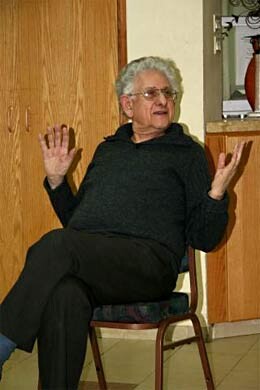
Mr. Elyakim Ha’itzni, a founder of the Kiryat Arba settlement in Hebron. (Photo: Bob Haynes)
After Israel’s independence, Mr. Ha’itzni became a lawyer in Tel Aviv. In 1967, after the war, he and others moved quickly to establish settlements on the ground in the newly conquered territories “before the army evacuates.”
It is true that both Jews and Arabs have had a historical presence in Hebron. For centuries, there was always a small Jewish population, which decreased dramatically after a 1929 Arab Hebronite massacre of 69 Hebronite Jews. 1967 brought an opportunity for settlers like Mr. Ha’itzni to re-establish a Jewish presence here. He left his law practice in Tel Aviv, and moved to Hebron, along with Rabbi Levinger, to establish Kiryat Arba.
He voices his frustration with current efforts to implement the Roadmap Peace Plan based on a Two State Solution, roughly based on UN resolutions 242 and 338:
“Jews are not being allowed to live in Judea. There is Jewish collaboration to ethnically cleanse Judea.”
He cites 120 years of Arab rejection and violence against Israel, “ever since 1882, and the first wave of Jewish Oylim.” Mr. Ha’itzni says the Arabs will only be satisfied with “the Blue Line,” that is, the Mediterranean Sea.
“As long as one house exists in Tel Aviv with a Jewish flag, the Arabs will not be satisfied… Before the British mandate, there were simply Arabs. After the British mandate, it was suddenly called Palestine, and the Arabs discovered that they were really Palestinians.”
According to Ha’itzni, “everything began in the wake of WWI. The British were aligned with Emir Abdullah of Transjordan”, and “Jews were being kept out. There were Jews wanting to settle in Judea and Samaria who were subsequently murdered by Hitler.”
He calls Yasser Arafat a “terrorist, a blood stained murderer … In the year 1964 the PLO was founded on the Mount of Olives in order to bring back the refugees… Any territories given to the Palestinians will be a springboard for them to take the rest.” He considers Arafat, and the new Palestinian leader Mahmood Abbas (Abu Mazen) “the same.”
Mr. Ha’itzni says that Jordan is the Palestinian State. “Of all the Arab nations, Jordan is the lesser bad. We need Jordan as the buffer state.”
In reference to Ariel Sharon’s unilateral Gaza Disengagement Plan, he states, “anything the Jews build ultimately is taken from them.” He opposes Sharon’s plan for withdrawing settlers from Gush Katif, the large settlement block that takes up a third of the beachfront of Gaza, as well as from the other 21 Gaza settlements that house 8,000 settlers in 40% of the Gaza Strip. “This may break Israel apart … Israel is being destabilized by the Bush Administration … Bush is the worse administration we have ever had… Madeline Albright hated her Jewish roots… Sharon is a peace criminal … 100-200 people will prevent disengagement from Gaza with our own bodies … the younger generation is even more dedicated than are we … Anti-Semitism is returning big-time… Strife is good for the blood circulation… Thomas Friedman is pro-Arab … Natan Sharansky speaks out about democracy… There is one Palestinian State, and it is called Jordan,” etc.
After our visit with Elyakim Ha’itzni, we visit the gravesite of Dr. Baruch Goldstein. Dr. Goldstein was a physician born and raised in Brooklyn who became a Kiryat Arba settler. In 1994, he opened fire on Muslims worshiping at the mosque of Ibrahim, killing 29 worshippers and injuring more than 100 in what became known as “The Hebron Massacre”, before he was bludgeoned to death by the crowd. In Kiryat Arba he is treated as a hero.
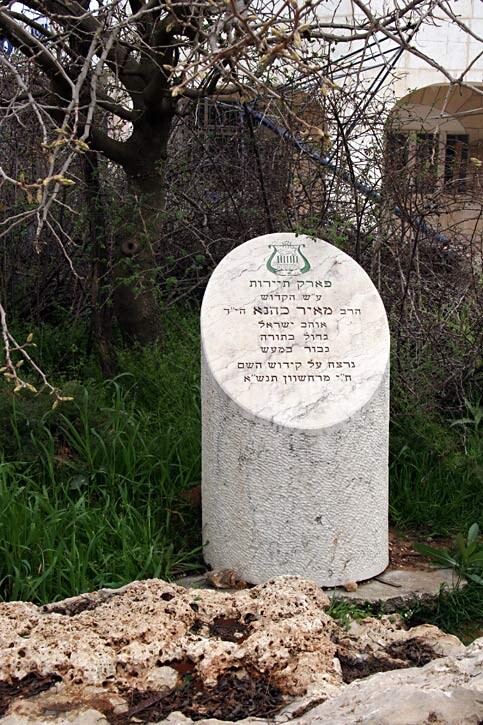
Memorial to Rabbi Meir Kahane of the Jewish Defense League (JDL) inside Kiryat Arba settlement. (Bill Dienst)
His grave is close to a memorial honoring Rabbi Meir Kahane, of the radical Jewish Defense League. The JDL was implicated in several bombings, including the offices of the American-Arab Anti-Discrimination Committee in Los Angeles. Meir Kahane was assassinated by an Egyptian assailant in New York City.
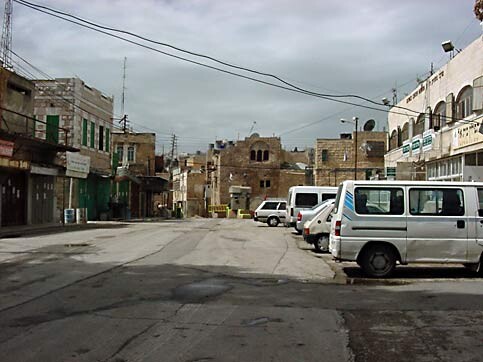
Central Hebron looks like a ghost town when under Israeli military curfew. (Photo: Bill Dienst)
Next we pass outside the fences of Kiryat Arba, past destroyed ancient Palestinian homes and into downtown Hebron, which looks like a ghost town. Yesterday, two Israeli soldiers were shot, so now the entire center of the city is under curfew and Palestinians cannot leave their homes.
We Western tourists can leave the bus, past the soldiers who are enforcing the curfew and into the Jewish Synagogue section of the Tomb of Abraham (Tomb of the Patriarchs). Since the Baruch Goldstein shooting, the building has been divided into two parts, a synagogue and a mosque. Prior to 1994, Muslims and Jews had separate visiting hours, but all sides had access to the whole shrine. Not so today. In fact, we are only able to visit the Jewish side of the shrine due to the curfew.
We are also planning to visit the offices of Christian Peacemaker Teams in Hebron. They are just down the street, but we cannot visit them today because of the curfew. Christian Peacemaker Teams (CPT) are an initiative of the historic peace churches (Mennonites, Church of the Brethren, and Quakers) with support and membership from a range of Catholic and Protestant denominations. CPT has a presence in Hebron and also the Village of At-Tuwani south of here. They also have a presence in Iraq and other hot spots in the world.
Now it is time to leave the Old City of Hebron, but we cannot; all of the roads out of Hebron are blocked because of the curfew. The only way out for us it to go back through the Kiryat Arba settlement.
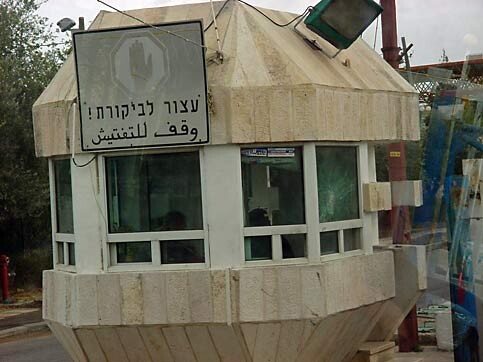
Guard post at Kiryat Arba. (Photo: Bill Dienst)
We are cleared through the checkpoint, but are blocked in front by a large van. Its driver has noticed that our bus driver is an Arab. Finally, after further negotiation, he moves out of the way, and we are allowed to pass. We have been besieged for only ten minutes, but it educates us on how the Palestinian inhabitants of central Hebron live. They are routinely besieged for hours, to days, to weeks at a time.
Next,: A visit with Terre des Hommes and Medecins Sans Frontieres in Hebron, and an interview with a survivor of the siege of the Church of the Nativity in Bethlehem in April, 2002.
Dr. Bill Dienst is a rural family and emergency room physician from Omak, Washington, USA. In March 2005, he traveled to Palestine and Israel as part of a delegation sponsored by Washington State Physicians for Social Responsibility (WaPSR). The delegation met with prominent Palestinians as well as members of the Israeli peace movement. They also traveled inside the Kiryat Arba’a settlement to hear a prominent member of the settler movement. In this series of articles, Dr. Dienst describes these meetings. Dr. Dienst has been to Israel-Palestine twice before. In November 2003, he spent 10 days in Gaza sponsored by Gaza Community Health Programme, and in 1985, he spent 4 1/2 months in Egypt the West Bank and Gaza sponsored by the Palestine Red Crescent Society.





